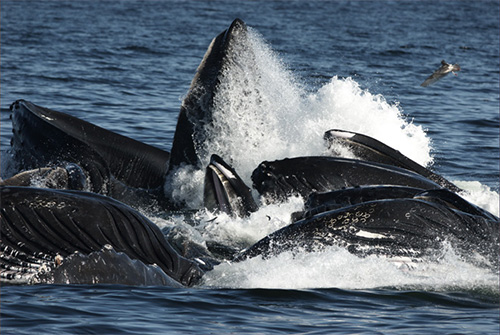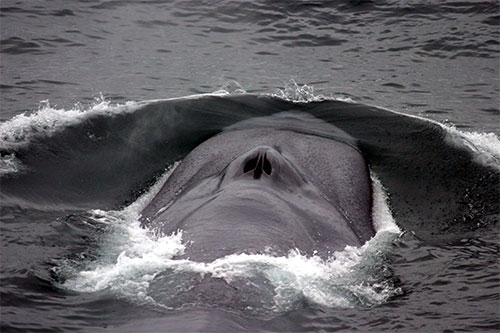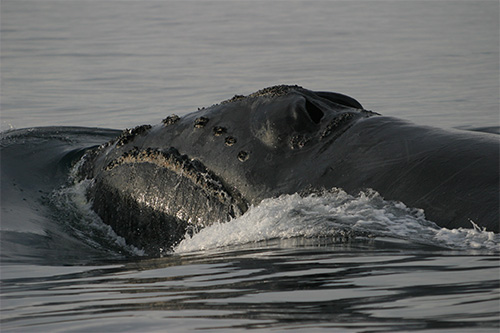
Meals on the go: The physics of whales' eating habits
June 08, 2017
Scientists hope that a greater understanding of how these aquatic mammals feed will shed light on how whales have evolved to the enormous sizes seen today. This new knowledge also will aid conservation efforts for whales, most of which are endangered species.
"As a physicist, I collaborate with biologists and paleontologists," Potvin said. "We study the physics of the various feeding mechanisms used by whales such as the humpback, blue and right whales. One practical aspect of this research is to know how much food they need. For the largest species, the food is krill and copepods. With climate change and human exploitation currently affecting prey availability, scientists wonder how whales will adjust to the possible food shortages or geographical displacements that are likely to arise. Answering how much food whales need to eat, or in other words, how much energy they have to spend throughout the year to catch and digest food, will help answer this question. "Blue whales, for example, feed on millions of krill that gather in big patches, in many cases patches that are larger than the whales themselves. This allows whales to grow to enormous sizes. These whales are the largest animals to have ever lived on Earth - they are larger than most dinosaurs. They engulf water and prey, and then filter what they don't need out through the baleen plates.
"There's still a lot we don't understand about filtration by baleen, especially with regards to the detailed physics involved. Blue whales lunge toward the prey patch and open their mouth to enormous gapes to catch as many prey as possible. In the process they engulf an enormous amount of water which needs to be filtered out instants after mouth closure. Blue whales engulf the equivalent of their own mass, which for a 90 foot-long whale translates into a hundred tons of water. This is a lot of water to purge out of the mouth. It's done after prey capture, with the whale's belly muscle tightening to force the water through the baleen, past the lips and out of the mouth. This is a complicated process, most of which is out of view. This leaves scientists with very few clues on the workings of the filtration process that takes place within." In their current paper, Potvin and Werth studied another type of baleen whale, the right whale, which offer a simpler version of filtration by baleen. Right whales have a baleen system that is similar to that of blue whales, although with longer baleen plates. But unlike their distant cousins the blue whales, right whales do not lunge and catch their prey like a raptor. Instead, they skim the water with their mouths open to collect their food at a much slower pace, effectively eating like a grazer. This process also is more visible since it is performed with the mouth partially opened. And, because of this skimming motion, the flow of water moving though the baleen system is simpler to simulate mathematically than the flows taking place inside a blue whale's closed mouth. Right whales feed on small prey called copepods which are about the size of a grain of rice.
"Copepods also hang out in big patches," Potvin said. "Whales open their mouths while swimming through the patch, effectively skimming through it in a manner similar to a collector's net capturing butterflies. Again the baleen act like a filtration surface but the copepods are smaller than the space between baleens and so the filtration process must be different from, for example, draining pasta using a strainer. "Instead, crossflow filtration is used, with most of the water passing through the baleen and exiting out of the mouth, but with the prey heading straight to the back side of the mouth where it is swallowed, all the while without ever coming into contact with the baleen.The copepods are mostly a slurry of food by the time they get to the whale's esophagus. "Humans developed crossflow filtration in the wine-making process to remove the particles created during production without requiring frequent cleaning of the filtration surface. Of course, Mother Nature knew about cross filtration long before we did." This is the first paper in the field that shows how this can be done for baleen whales through simulations and data, Potvin says. "This is a study of how the water flows through the mouth in terms of speed and pressure, and how this leads to the drag created by the open mouth," Potvin said. "When these whales open their mouths, there is more water resistance because of the flow within. This will affect how much energy the whale needs to spend in order to feed. We can calculate the drag. People had measured it but it had never been calculated. I think it's a big step. "Another thing this analysis allows you to do is to go back to the question of body size. This type of crossflow filtration works best with a big body size. Right whales are about 50 feet-long. Our analysis found that, sure enough, this mode gets more efficient at the larger body size. "The bigger the filter, the slower the water through the filter. This reduces the clogging rate and also the drag. If water is too fast through the baleen system, it carries along most of the prey, thereby allowing the copepods to escape and over time gums up the filter. The bigger the filter surface, the slower the flow out of the filter at the level of the pore. The process is analogous to rivers discharging into a bay: the faster river flow -- equivalent to the water entering a whale's mouth -- will always slow down as it enters the bay because it is always wider, which is equivalent to the water passing through the whale's baleen." This modeling answers some key questions about feeding that will help scientists understand how to best protect whales as their habitat changes due to global warming and human activity on oceans. For his next project, Potvin will turn his attention to the physics of how whales swim and maneuver in the water. Thanks to a recent $800,000 grant from the National Science Foundation (NSF), Potvin and colleagues will collect data on the swimming habits of blue whales and humpback whales in the wild using drones and electronic tags. Potvin and Saint Louis University received $232,634 to fund their portion of the three year study. "We will have a big expedition in August near the Channel Islands off the coast of Santa Barbara, California, tagging blue whales," Potvin said. "We are likely to see some of the highest concentrations of blue whales in the world. We hope to get a lot of data out of that trip." The expedition will be led by colleagues at Stanford University's Hopkins Marine Station using specially devised digital tags to measure the speeds and accelerations performed by the whales, as well as record video of the maneuvers and encounters with the prey. "Researchers usually sneak up next to a whale as it surfaces for air and attempt to attach the tag to the animal with the use of suction cups," Potvin said. "There is a piece of metal that dissolves after several hours after attachment and that releases the suction cups. The package then floats up to the surface and a mounted beacon helps the biologists locate and retrieve the tag for data download." With the new data, Potvin will be able to carry out computational fluid dynamics simulations at Saint Louis University to learn more about how these whales maneuver to capture prey, avoid predators and obstacles, and compete for mates.
On the Web:
Editing by Mary Kauffman, SitNews
Source of News:
Representations of fact and opinions in comments posted are solely those of the individual posters and do not represent the opinions of Sitnews.
|
|||||


